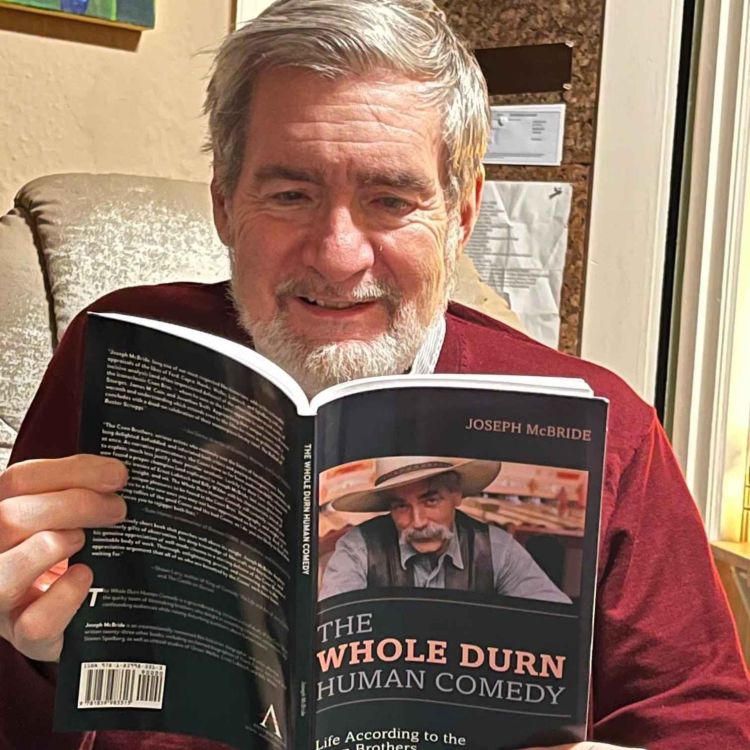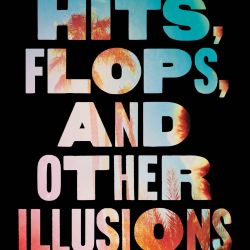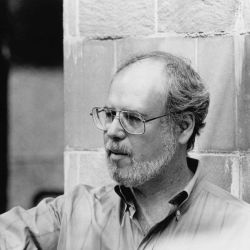Share

Writers on Film
Joseph McBride's The Whole Durn Coen Brothers Comedy
Joseph McBride has written a ton of books, as well as writing screenplays and television specials. The subjects of his work include baseball slang, JFK, and biographies of Frank Capra, Billy Wilder and John Ford. His latest is a superb exploration of the work of the Coen Brothers. Here's the blurb:
The Coen Bros. have attracted a wide following and have been rewarded with Oscars and other honors. Some of their films such as Fargo, The Big Lebowski, and No Country for Old Men are cult favorites and box office hits. Yet this team of filmmaking brothers remains misunderstood in some critical circles, partly because, like John Ford, they mischievously refuse to explain themselves to interviewers, preferring to let their work speak for itself. Ethan and Joel Coen also delight in unsettling cinematic conventions and confounding audiences while raising disturbing questions about human nature.
Mixing film genres and styles, playing with narrative in postmodernist ways, the Coens’ films display shocking tonal shifts as they blend comedy and drama and, most controversially, comedy and violence. This potent mélange of themes and stylistic approaches makes the Coens’ films adventurous, unpredictable probes into social anxieties and reflections on the omnipresence of evil in the modern world. In their trenchant satire, these brilliant writer-directors are heirs to Preston Sturges and Billy Wilder, and as satirists tend to do, the Coens sometimes provoke audience anger and incomprehension along with enjoyment of their penchant for black comedy.
Film historian and critic Joseph McBride jousts with the Coens’ detractors while defining the filmmakers’ freshness and originality. The quirkily individualistic Coens are the kind of personal filmmakers the increasingly conglomerated American cinema rarely fosters anymore, a distinction partly attributable to their following in Europe and their partial financing by European sources. This critical study goes beyond the often-superficial and confused nature of Coen criticism to illuminate their artistic personalities and contributions to cinematic culture.
More episodes
View all episodes

154. Roger Lewis talks Erotic Vagrancy
01:07:22Richard Burton and Elizabeth Taylor were a Sixties supercharged couple in an era of supercharged couples. As a pairing they were fantasy figures, impossibly desirable. Liz supple and soft, in perfumes and furs - yet with something demonic and lethal about her. Dick, in turn, with his ravaged, handsome face, looked as though lit by silver moonlight - poised to turn into a wolf. Roger Lewis uses this glamorous and damaged pair as the starting point to tell the story of an age of excess: the freaks and groupies, the private jets and jewels and the yachts sailing in an azure sea; the magnificent bad taste and greed. It is about the clash of worlds: the filth and decay of South Wales and the grandeur and elegance of Old Hollywood; the fantasies we have about film stars and the fantasies the Burtons had about each other.
153. Paul Duncan on Dr. No
01:07:32Paul Duncan talks Dr. No, and the making of James Bond's first cinematic asdventure. Book now available from Taschen.
152. Ed Zwick on Hits, Flops, and Other Illusions
49:51A NEW YORK TIMES BESTSELLER * LOS ANGELES TIMES BESTSELLER * USA TODAY BESTSELLERThis heartfelt and wry career memoir from the director of Blood Diamond, The Last Samurai, Legends of the Fall, About Last Night, and Glory, creator of the show thirtysomething, and executive producer of My So-Called Life, gives a dishy, behind-the-scenes look at working with some of the biggest names in Hollywood.“I’ll be dropping a few names,” Ed Zwick confesses in the introduction to his book. “Over the years I have worked with self-proclaimed masters-of-the-universe, unheralded geniuses, hacks, sociopaths, savants, and saints.”He has encountered these Hollywood types during four decades of directing, producing, and writing projects that have collectively received eighteen Academy Award nominations (seven wins) and sixty-seven Emmy nominations (twenty-two wins). Though there are many factors behind such success, including luck and the contributions of his creative partner Marshall Herskovitz, he’s known to have a special talent for bringing out the best in the people he’s worked with, especially the actors. In those intense collaborations, he’s sought to discover the small pieces of connective tissue, vulnerability, and fellowship that can help an actor realize their character in full.Talents whom he spotted early include Brad Pitt, Matt Damon, Denzel Washington, Claire Danes, and Jared Leto. Established stars he worked closely with include Leonardo DiCaprio, Anthony Hopkins, Tom Cruise, Julia Roberts, Anne Hathaway, Daniel Craig, Jake Gyllenhaal, Bruce Willis, Demi Moore, and Jennifer Connelly. He also sued Harvey Weinstein over the production of Shakespeare in Love—and won. He shares personal stories about all these people, and more.Written mostly with love, sometimes with rue, this memoir is also a meditation on working, sprinkled throughout with tips for anyone who has ever imagined writing, directing, or producing for the screen. Fans with an appreciation for the beautiful mysteries—as well as the unsightly, often comic truths—of crafting film and television won’t want to miss it.
151. Robert P Kolker and Marsha Gordon talk Film, Form and Culture
57:17This fifth edition of Film, Form, and Culture by Robert P Kolker and Marsha Gordon offers a lively introduction to both the formal and cultural aspects of film.Additional resources for students and teachers can be found on the eResource, which includes case studies, discussion questions, and links to useful websites.Get the book HERE.
150. Neil Alcock talks Hitchcock and Hitchology
50:45MURDER! MOTHERS! MEN ON THE RUN!Film fans know these are just a few key ingredients of Alfred Hitchcock’s movies. When Hitchcock fused these elements with his innovative directorial approach, that blend of familiar themes and stylistic ingenuity became known as ‘Hitchcockian’. In a refreshingly original way, HITCHOLOGY considers how Hitchcock used these narrative tropes and formal flourishes to create some of cinema’s most unforgettable experiences.Alongside unique takes on every film and TV episode Hitchcock directed, HITCHOLOGY also examines his collaborators, his cameos, other films in the Hitchcock cinematic universe, and more. Passionately written with wit and warmth, HITCHOLOGY is an accessible introduction for newcomers to Hitchcock, and an insightful companion for devoted fans.Buy the book HERE.
149. Oscar Winning Screenwriter Bruce Rubin talks about his Life
01:06:48Bruce Joel Rubin is the Oscar winning screenwriter of Brainstorm, Ghost and Jacob's Ladder among others. His memoir It's Only a Movie is availbale here. And his book Three Visionary Screenplays is also available via this link.
148. Christian Esquevin talks Designing Hollywood
46:59Since the 1920s, fashion has played a central role in Hollywood. As the movie-going population consisted largely of women, studios made a concerted effort to attract a female audience by foregrounding fashion. Magazines featured actresses like Jean Harlow and Joan Crawford bedecked in luxurious gowns, selling their glamour as enthusiastically as the film itself. Whereas actors and actresses previously wore their own clothing, major studios hired costume designers and wardrobe staff to fabricate bespoke costumes for their film stars. Designers from a variety of backgrounds, including haute couture and art design, were offered long-term contracts to work on multiple movies. Though their work typically went uncredited, they were charged with creating an image for each star that would help define an actor both on- and off-screen. The practice of working long-term with a single studio disappeared when the studio system began unraveling in the 1950s. By the 1970s, studios had disbanded their wardrobe departments and auctioned off their costumes and props. In Designing Hollywood: Studio Wardrobe in the Golden Age, Christian Esquevin showcases the designers who dressed Hollywood's stars from the late 1910s through the 1960s and the unique symbiosis they developed with their studios in creating iconic looks. Studio by studio, Esquevin details the careers of designers like Vera West, who worked on Universal productions such as Phantom of the Opera (1925), Dracula (1931), and Bride of Frankenstein (1931); William Travilla, the talent behind Marilyn Monroe's dresses in Gentleman Prefer Blondes (1953) and The Seven Year Itch (1955); and Walter Plunkett, the Oscar-winning designer for film classics like Gone with the Wind (1939) and An American in Paris (1951). Featuring black and white photographs of leading ladies in their iconic looks as well as captivating original color sketches, Designing Hollywood takes the reader on a journey from drawing board to silver screen.
147. Tom Shone on the Oscars and Dune Part 2
01:21:13Tom Shone is the bestselling author of The Nolan Variations, among several other books on cinema.
146. Stephen Lee Naish on Dennis Hopper, film director
01:03:35Stephen's book is availble here. Across his directorial films, American filmmaker Dennis Hopper used music and sound to propel the narrative, signpost the era in which the films were made, and delineate the characters’ place within American culture. This book explores five of Hopper’s films to show how this deep engagement with music to build character and setting continued throughout his career, as Hopper used folk, punk, hip-hop, and jazz to shape the worlds of his films in ways that influenced other filmmakers and foreshadowed the advent of the music video format.The author traces Hopper’s distinctive approach to the use of music through films from 1969 to 1990, including his innovative use of popular rock, pop, and folk in Easy Rider, his blending of diegetic performances of folk and Peruvian indigenous music in The Last Movie, his use of punk rock in Out of the Blue, incorporation of hip-hop and rap in Colors, and commissioning of a jazz/blues soundtrack by Miles Davis and John Lee Hooker for The Hot Spot. Uncovering the film soundtrack as a vital piece of the narrative, this concise and accessible book offers insights for academic readers in music and film studies, as well as all those interested in Hopper’s work.